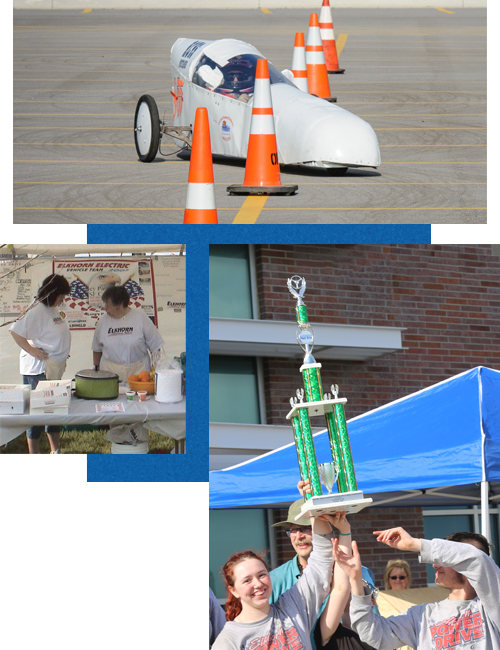Competitions
Five events make up the competition, with the weighting of each expressed as “points” that total up to an overall score:
Endurance (600 points out of 1,200 possible):
Vehicles run in a “heat” (a race) for one hour on a closed track. The vehicle with the most laps wins. Vehicles must make a “pit stop” in the middle of the heat to change drivers, which doubles the number of driving participants and gets a four-student pit crew involved. Once the heat begins, the vehicle’s batteries may not be replaced or recharged.
Braking (100 out of 1,200):
In a straight line, vehicles drive into a “stopping zone” and stop in as short a distance as possible. Electronic devices measure the stopping distance and speed.
Maneuverability (100 out of 1,200):
Vehicles navigate a series of five cones, each spaced 25’ apart, with the shortest elapsed time winning the event. There are penalties for hitting or skipping a cone, or if a wheel leaves the ground (which is an unsafe way to drive).
Design & Construction (100 out of 1,200):
This is a non-driving event in which judges score each vehicle across a series of factors, such as craftsmanship, innovation, appearance, and roadworthiness. The highest-rated vehicle wins the event.
Documentation (300 out of 1,200):
This is another non-driving event in which each vehicle team writes a “Journal” describing everything about the team and vehicle. Example topics are short biographies of team members and their roles, the vehicle’s design, how that design was converted into an actual vehicle, testing process, lessons learned, a parts list, etc. In one competition class, a five-minute multimedia “marketing” presentation must be submitted. Judges score each Journal, and the high score wins the event.

Competitions take place in rallies that usually last most of the day (including travel time). The rallies run on a variety of surfaces, from speedway tracks to blocked-off parking lots. The shortest track is one quarter mile. The longest is almost one and a half miles.
There are four competition Classes in Power Drive. These classes are not based on school size, but rather the age of the vehicle and the recent history of the team.
- Novice Class: Vehicles that are built by teams that are new or have not won a rally in the past three years
- Standard Class: Vehicles running in their first year of competition.
- Advanced Class: Vehicles running in their second or third year of competition.
- Exhibition Class: Vehicles running in their fourth (or more) year of competition, as well as all college teams.

